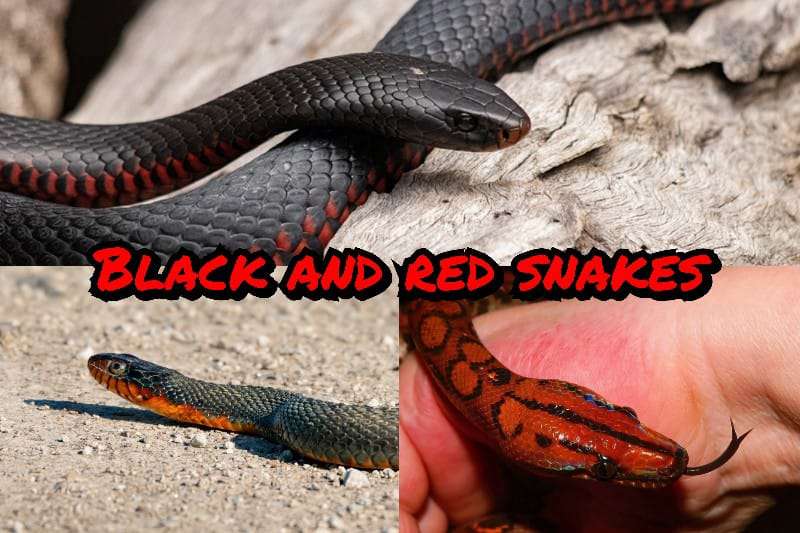Today we are back with another exciting topic. Many types of snakes worldwide have distinct colors, sizes, and patterns. Amongst them, here we will discuss black and red snakes, or we can say that snakes that are black and red.
Many people believe that black and red snakes are venomous, but it’s not entirely true. There are many black and red snake species; only a few are venomous or pose a danger to humans. Most of them are mild or non-venomous.
In the following list, some snakes are multicolor and have only black and red strips, while others are predominately in red and black hues. So, from venomous coral snakes to beautiful worm snakes, let’s begin the article on black and red snakes.
Black and Red Snakes List
1) Red-Bellied Black Snake

Red-bellied black snakes, also known as Common Black Snakes, are Australia’s most common black and red snakes.
These snakes are venomous, and their venom contains neurotoxins, myotoxins, and coagulants which result in local swelling, prolonged bleeding, nausea, headaches, and intense pain.
Red-bellied black snakes primarily feed on frogs, small reptiles, and mammals. They are in shiny black color with pale brown snout, and their lateral scale rows are in dull red or orange color.
Red-bellied black snakes are to be found near rivers, lakes, and lagoons within forests or woodlands.
Scientific name: Pseudechis porphyriacus
Size: 1.5-2m
Location: northern and central eastern Queensland, eastern New South Wales, and Victoria
2) Striped Coral Snake (Black Snake with Red Stripes)
Another venomous snake on the list is the Striped Coral Snake, also called the Black Coral Snake.
These red and black snakes are endemic to the Western Ghats, India. Their venom comprises potent neurotoxins, which act like a deadly poison for humans if left untreated.
Like other coral snakes, a bite from a Striped Coral Snake is seldom lethal, but its excessive dose can lead to significant problems.
These coral snakes are the second largest coral snake of the genus Calliophis after the Harlequin snake.
Striped Coral Snakes have long slender bodies with shiny red scales and black longitudinal stripes from head to tail. They primarily feed on small snakes, lizards, frogs, nestling birds, and other small rodents.
Scientific name: Calliophis nigriscens
Size: up to 114cm
Location: Western Ghats, India
3) Black Swamp Snake
Black Swamp Snakes, also known as swamp snakes, are non-venomous semi-aquatic snake endemic to the southeastern United States.
There are three subspecies of Black Swamp Snakes: South Florida swamp snake, Carolina swamp snake, and North Florida swamp snake. These snakes have shiny black scales with bright red bellies and markings on the edges.
Black Swamp Snakes mainly feed on small fish, tadpoles, frogs, salamanders, and invertebrates, such as leeches and earthworms.
Scientific name: Liodytes pygaea
Size: 25-38cm
Location: North Carolina, South Carolina, Georgia, Alabama, and Florida
4) Arizona Coral Snake
Another venomous snake on the list is Arizona Coral Snake. These snakes have red, black, and yellow or white stripes from head to tail.
They are also known as Western Coral Snakes or Sonoran Coral Snakes.
Arizona Coral Snakes are very small in size, but their venom is extremely dangerous. The people of Arizona are well aware of this snake.
Their venom does not pose much danger to humans because they emit in minimal quantities.
However, an increase in the dose of its venom can lead to fatal problems. They mainly feed on blind and black-headed snakes and small lizards.
Scientific name: Micruroides euryxanthus
Size: 13-24 inches
Location: Central and Southern Arizona
5) Sonoran Shovel-Nosed Snakes
The next member on the list of black and red snakes is Sonoran Shoval-Nosed Snakes. These tri-color snakes are non-venomous and look similar to Sonoran Coral Snakes.
The primary difference between them is the snout. Sonoran Shovel-Nosed Snake has a yellow snout, while Sonoran Coral Snake has a black snout. In addition, the tri-color patterns on their respective bellies are different.
Sonoran Shovel-Nosed Snakes are slightly bigger than coral snakes and primarily feed on beetles, spiders, crickets, centipedes, and other insects.
Scientific name: Sonora palarostris
Size: 17 inches (maximum length)
Location: the southwestern United States and northwestern Mexico
6) Scarlet Kingsnake
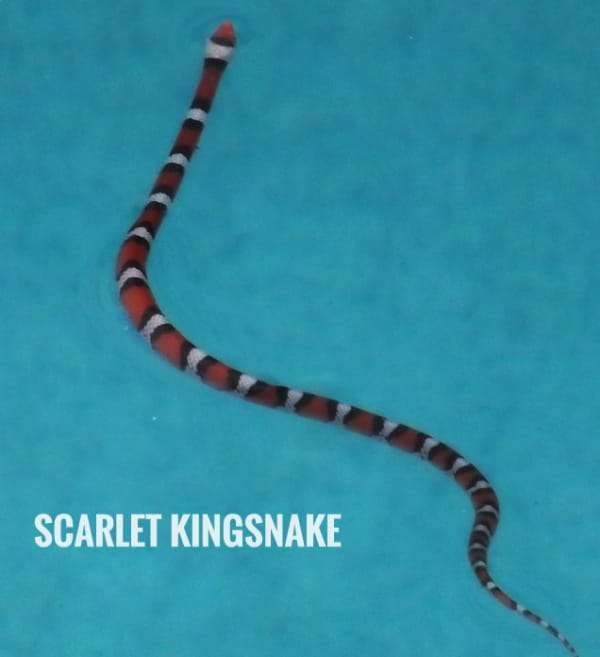
Scarlet Kingsnake is a milk snake species with tri-color stripes all over the body. These snakes are red in color with black, white, or yellow circular bands from head to tail. Scarlet Kingsnakes are very beautiful and non-venomous.
They can easily be seen throughout Georgia. These snakes mainly feed on mice and other small rodents and snakes. Scarlet Kingsnakes can live up to 12 to 13 years.
Scientific name: Lampropeltis elapsoides
Size: 14-20 inches
Location: throughout Georgia
7) Pueblan Milk Snake
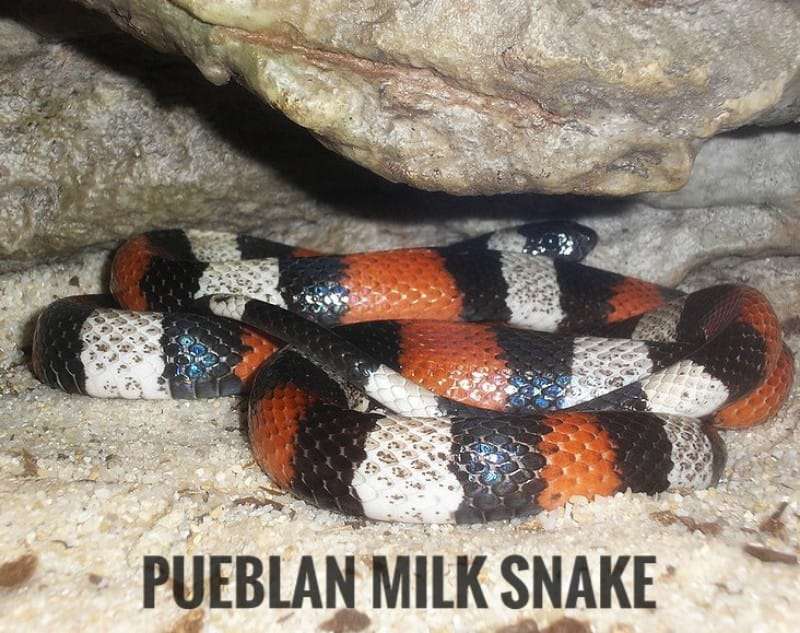
Another tri-color non-venomous snake on the list is Pueblan Milk Snake. It is also called Campbell’s milk snake.
In this list of snakes that are black and red, Pueblan Milk Snakes are the second most beautiful snakes after rainbow snakes.
Because, unlike other milk snakes, Pueblan Milk snakes have perfectly white, black, and red wide shiny bands.
In captivity, the life span of the Pueblan Milk Snake can reach more than 20 years. These snakes are larger than the Arizona Coral snakes and feed on mice, rats, frogs, birds, and other snakes.
Scientific name: Lampropeltis triangulum campbelli
Size: 36 to 48 inches
Location: southern Puebla, eastern Morelos, and northern Oaxaca, Mexico
8) Ring-necked snakes
Ring-necked snakes are non-venomous small terrestrial snakes with red rings around their necks. These snakes are nocturnal, meaning they can be seen mostly at night.
The upper part of their scales is bluish-gray or black in color, while their bellies are either red or yellow-orange with the same color neckband. Ring-necked snakes occur in a wide variety of habitats, from open woodlands to hills.
These small snakes primarily feed on smaller lizards, earthworms, frogs, and slugs. The average life span of ring-necked snakes in the wild is nearly ten years.
Scientific name: Diadophis punctatus
Size: 21-36cm
Location: southern Canada, Florida, Pacific coast
Must Read: What colors do Snakes see? Snake Vision
9) Eastern Mud snake
Farancia abacura abacura is the scientific name of the Eastern Mud Snake, which is also regionally called by many names like a checkered snake, dart snake, eastern horn snake, hoop snake, stinging snake, bellied snake, etc.
Eastern mudsnakes are commonly found in the southeastern area of the United States.
It is a harmless snake with shiny black scales outlined with cream and has big red patches on its ventral side. Its habitat includes swamps, wetlands, mud bottom creaks, lakes, etc.
Eastern Mudsnakes are nocturnal species but are burrowing snakes.
Their diet includes aquatic amphibians, tadpoles, salamanders, small frogs, and fish. The mudsnake can grow up to a total length of 54 inches. Female ones are slightly larger than the male ones.
Scientific name: Farancia abacura abacura
Size: 40 – 54 in. (102 – 137 cm).
Location: Alabama, Arkansas, Florida, Georgia, Illinois, Kentucky, Louisiana, Mississippi, Missouri, North Carolina, Oklahoma, South Carolina, Tennessee, Texas, and Virginia
10) Western Ground Snake
The Western Ground snake, commonly called Common Ground Snake or variable ground snake, is a harmless colubrid snake found in the Southeastern United States. They’re found in dry, rocky areas with loose soil.
Ground snake is also nocturnal species and primarily hunts down invertebrates, like spiders, scorpions, centipedes, crickets, and insect larvae.
They can grow up to 19 inches and can be seen in various colors like brown, red, and orange, with a smooth dorsal scale on their abdomen.
They generally have a lifespan of 15 to 20 years, but their biggest threats include larger snakes. Western Ground Snakes are not venomous and hence are harmless.
Scientific name: Sonora semiannulata
Size: 8 to 19 inches
Location: Arizona, Nevada, California, Colorado, Kansas, Missouri, New Mexico, Oklahoma, Oregon, Texas, and Utah, as well as northern Mexico, in Chihuahua, Coahuila, Durango, Nuevo León, and Sonora
11) Western Worm Snake
The western worm snake is a small colubrid snake that is found in the United States. It is a non-venomous snake of size maximum of up to 14.5 inches.
It has beautiful plain black scales on the dorsal side and orange scales on the ventral side. Worm snakes are burrowing snakes and spend most of their time beneath or under damp forest leaf litter or in rocky soil.
As their name suggests, their diet includes earthworms, small worms, and soft-bodied insects. One of their characteristics is that if touched or annoyed, they release a foul smell as a defense mechanism.
Scientific name: Carphophis vermis
Size: 7.5 – 14.5 inches
Location: Southern Iowa, southeastern Nebraska, eastern Kansas, western Illinois, Missouri, Louisiana, eastern Oklahoma, and northeastern Texas, with isolated records from southwestern Wisconsin, southeastern Arkansas, and middle Tennessee
12) Thornscrub Hook-nosed Snake
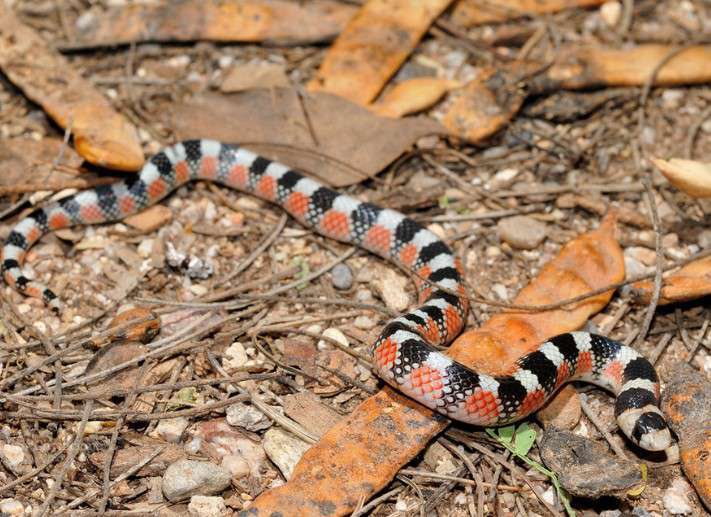
The binomial name of the Thornscrub Hook- Nosed snake is Gyalopion quadrangulare, found in the southwestern United States and Mexico. It is a small non-venomous colubrid snake with a total length of 10 inches.
Gyalopion species have smooth, shiny scales and are shown in varied colors like black, cream, and orange. They have a cream-colored body with long orange strips on either side with black blotches or black bars on the dorsal side.
They show nocturnal habits and are burrowing secretive snakes. Thornscrub hook-nosed snake primarily feeds on anthropods like spiders, insects, etc.
Scientific name: Gyalopion quadrangulare
Size: 10 inches
Location: Southwestern United States and Mexico
13) Eastern Hognose Snake
The Eastern Hognose Snake, commonly called a spreading adder, is a species of Colubridae family that are mildly venomous and rear-fanged snakes.
This species is found in North America from eastern-central Minnesota and Wisconsin to southern Ontario and extreme southern New Hampshire.
They are found in sandy pine forests, old fields, and on forests’ edges. They’re also burrowing snakes and require sandy loose soil for burrowing. Eastern hognose snakes have a maximum size of 41 inches having variably color patterns.
Depending on their locality, they can be red, black, brown, green, orange, gray, or black. Pattern includes blotched, checkered, or plain but only on the dorsal side.
Hognose Snakes are nonvenomous to humans, but their scientific name is Heterodon, which means ‘different tooth’; these teeth inject venom into mild amphibians.
Whenever they feel threatened or get frightened, they flatten their necks and raise their heads off the ground like a cobra. Eastern hognose feeds exclusively on amphibians like toads, frogs, and salamanders.
Scientific name: Heterodon platirhinos
Size: 28- 41 inches
Location: North America
14) Pygmy Rattlesnake
Pygmy rattlesnake, whose scientific name is Sistrurus miliarius is a species of venomous snake of the family Viperidae.
They are found in the Southeastern United States from southern and eastern North Carolina, south through peninsular Florida, and west to East Texas and Oklahoma and also popularly called eastern Pygmy rattlesnakes, ground rattlesnakes, leaf rattlers, and death rattlers.
They are small in size, about 16-24 inches but can reach up to 31 inches as well. Their male ones are larger than the female species.
They also have varied color patterns, including brown-black bodies with oval spots of black with a narrow red lining on the dorsal part of the abdomen, and their scales are dull and rough.
Pygmy rattlesnake inhabits Flatwoods, sandhills, lakes, marshes, and floodplains. Their diet includes small mammals, birds, lizards, insects, and rodents.
This rattlesnake is unable to produce a large amount of venom. Therefore, these snakes are not likely to give fatal bite to humans ever get bitten by this.
Scientific name: Sistrurus miliarius
Size: 16- 24 inches
Location: Southeastern United States
15) Rainbow Boa
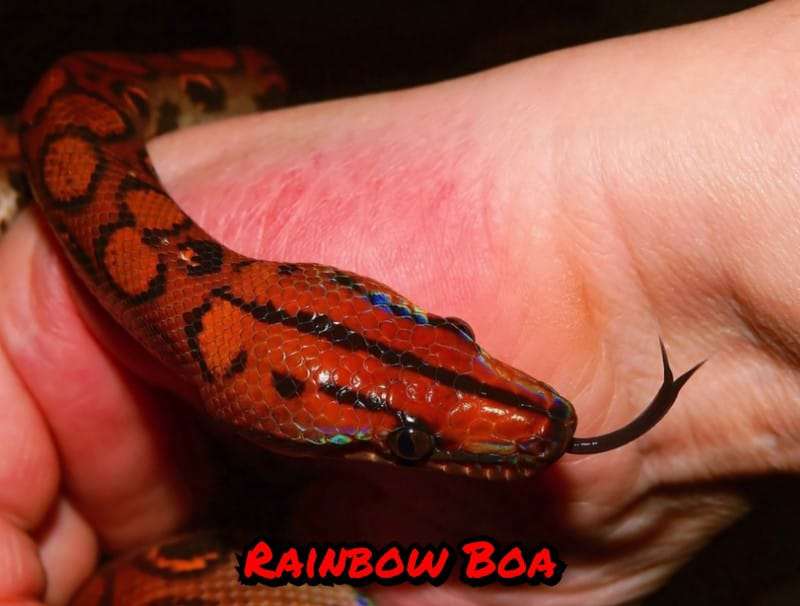
We know that you’re thinking of why we have inserted the name, Rainbow Boa. It’s because these snakes have many sparkling colors and are one of the most beautiful snakes in the world.
These large snakes are non-venomous and found in lower Central America and South America. Rainbow Boas, also known as Brazilian rainbow boas are terrestrial snakes, and most people keep them as pets.
However, in some places, keeping them as pets is illegal. These snakes mainly feed on large lizards, small or moderate-sized birds, rodents, and other small mammals. It is estimated that Rainbow Snakes can live nearly 30 years in captivity.
Scientific name: Epicrates cenchria
Size: 1.2-1.8 meters
Location: Amazon River basin, coastal Guyana, French Guiana, Suriname, and southern Venezuela
16) Texas Indigo Snake
Texas Indigo Snake is a diurnal and terrestrial snake that can be found in southern/central Texas. These snakes are also popular as Texas blue indigo, blue indigo snake, and indigo snake.
These snakes mainly feed on small native venomous snakes, lizards, and frogs. Texas Indigo Snakes are also known for chasing down, overpowering, and eating rattlesnakes. Its body is in black-indigo color with a reddish-brown belly.
Scientific name: Drymarchon melanurus erebennus
Size: 14-24 inches
Location: Texas, from San Antonio south, and into northern Mexico as far south as Veracruz
Other List
-
17) Banded Malaysian Coral Snake*
-
18) Eastern Milk Snake
-
19) Western Milk Snake
-
20) Mexican Milk Snake
-
21) Miami Corn Snake
-
22) Central American Milk Snake
-
23) South American Milk Snake
-
24) Florida Scarlet Snake
-
25) Southern ringneck snake
-
26) San Bernardino ring-necked snake
-
27) Coralbelly ring-necked snake
-
28) Prairie Ringneck Snake
-
29) Western Mud Snake
-
30) Texas Coralsnake*
-
31) Eastern Coralsnake*
-
32) Gray-banded kingsnakes
-
33) Eastern Worm Snake
-
34) Sharp-Tailed Snake
-
35) Red-bellied mud snakes
-
36) Rainbow Snake
(*) denotes venomous.
Here, we conclude our article on “Red and Black Snakes.” These are the snakes from distinct species. We hope you like our post. We will be back with another interesting post. Till then, stay tuned with us and read the articles mentioned below.
Also Read:

Meet Abhidept (nickname Monty), the visionary founder of How It See, being an engineering student, he’s fueled by an insatiable curiosity about the world around him. He is captivated by an eclectic correlation between animal groups, science, and nature, and this fascination drives his quest for understanding.
After completing his degree, he’s set on a mission to delve deep into the realm of nature, accumulating knowledge to share with you through his writing. In the meantime, he loves to watch anime and read anime.
